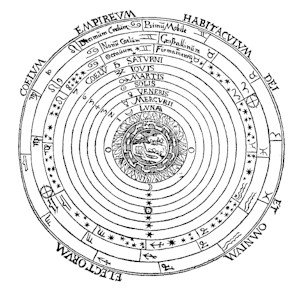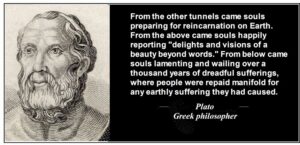This site uses affiliate links to Amazon.com Books for which IANDS can earn an affiliate commission if you click on those links and make purchases through them.
1. One of the Earliest Recorded NDEs
The ancient Greek philosopher Plato’s Myth of Er, found at the conclusion of his famous work The Republic, offers one of the earliest recorded depictions of a near-death experience (NDE). The term “myth” in this context does not imply that the story is false or purely fictional, but rather that it is a narrative crafted to convey deeper truths. In the Myth of Er, Plato presents the story of Er, a soldier who dies in battle but miraculously revives twelve days later to recount his journey to the afterlife. The myth portrays Er’s vivid encounter with otherworldly realms, where he witnesses the fate of souls, the cycles of reincarnation, and the ultimate rewards and punishments of just and unjust lives.
This account shares striking similarities with modern near-death experiences. Er’s description of traveling beyond his physical body, encountering a place of divine judgment, and witnessing the souls’ journey into the afterlife parallels the reports of individuals who have had NDEs. Many NDE survivors describe traveling through tunnels, experiencing life reviews, and feeling a profound connection to a higher reality—just as Er describes in his journey.
Plato uses the Myth of Er to explore deeper philosophical questions about the soul, morality, and the afterlife, illustrating the enduring power of near-death experiences to offer insight into the nature of existence and the afterlife. By examining the myth through the lens of modern NDEs, we gain a timeless perspective on the human fascination with life beyond death and the mysteries of the soul’s journey.
2. Plato’s NDE Testimony
Some of the following information about Plato and his NDE testimony about the soldier named Er are excerpts from Lee W. Bailey and Jenny Yates book, The Near-Death Experience: A Reader.
Reports of near-death experiences (NDEs) are not a new phenomenon. Many NDEs have been reported for over the last two thousand years. Ancient religious texts such as the New Testament of the Bible (367 AD), the Quran (632 AD), and the Tibetan Book of the Dead (1386 AD), for example, describe experiences of life after death which remarkably resemble modern NDEs. The oldest surviving explicit report of an NDE in Western literature comes from the famed Greek philosopher, Plato, who described an event, the “Myth of Er,” in the tenth book of his legendary book entitled Republic written in 380 BC. The Myth of Er is a legend that concluded Plato’s Republic which includes an account of the cosmos and the afterlife that greatly influenced religious, philosophical, and scientific thought for many centuries. The story begins as a man named Er, son of Armenios of Pamphylia, who died in battle. When the bodies of those who died in the battle are collected, ten days after his death, Er’s body remained undecomposed. Two days later he revives on his funeral pyre and tells others of his journey in the afterlife, including an account of reincarnation and the celestial spheres of the astral plane. The tale includes the idea that moral people are rewarded and immoral people punished after death. Although called the “Myth” of Er, the word “myth” means “word, speech, account”, rather than the modern meaning. The word is used at the end when Socrates explains that because Er did not drink the waters of Lethe, the account (mythos in Greek) was preserved for us.
This story is not just a random anecdote for Plato. He integrated at least three elements of the NDE into his philosophy: the departure of the soul from the cave of shadows to see the light of truth, the flight of the soul to a vision of pure celestial being and its subsequent recollection of the vision of light, which is the very purpose of philosophy.
In Plato’s Republic, he concludes his discussion of immortal soul and ultimate justice with the story of Er. Traditional Greek culture had no strong faith in ultimate justice, as monotheistic faiths do. Ancestral spirits lingered in the dark, miserable underworld, Hades, regardless of their behavior in this life, with no reward or punishment, as Odysseus learned in his Odyssey. But Plato, perhaps importing some Orphic, Egyptian or Zoroastrian themes, drew on the idea of an otherworldly reward or punishment to motivate virtuous behavior in this life. The first point of Er’s story is to report on this cosmic justice; it is:
“..the tale of a warrior bold, Er, the son of Armenious, by race a Pamphylian. He once upon a time was slain in battle, and when the corpses were taken up on the tenth day already decayed, he was found intact, and having been brought home, at the moment of his funeral, on the twelfth day as he lay upon the pyre, revived, and after coming to life related what, he said, he had seen in the world beyond. He said that when his soul went forth from his body he journeyed with a great company and that they came to a mysterious region where there were two openings side by side in the Earth, and above and over against them in the heaven two others, and that judges were sitting between these, and that after every judgment they bade the righteous journey to the right and upward through the heaven with tokens attached to them in front of the judgment passed upon them, and the unjust to take the road to the left and downward, they too wearing behind signs of all that had befallen them, and that when he himself drew near they told him that he must be the messenger to humanity to tell them of that other world, and they charged him to give ear and to observe everything in the place.” (Rep. X,614 b,c,d)
From the other tunnels came souls preparing for reincarnation on Earth. From above came souls happily reporting “delights and visions of a beauty beyond words.” From below came souls lamenting and wailing over a thousand years of dreadful sufferings, where people were repaid manifold for any earthly suffering they had caused. Journeying on, the newcomers saw:
“..extended from above throughout the heaven and the Earth, a straight light like a pillar, most nearly resembling the rainbow, but brighter and purer … and they saw there at the middle of the light the extremities of its fastenings stretched from heaven, for this light was the girdle of the heavens like the undergirders of triremes, holding together in like manner the entire revolving vault.” (Rep. X, 616 b,c)
With many other souls as his companions, Er had come across an awe-inspiring place with four openings – two into and out of the sky and two into and out of the ground. Judges sat between these openings and ordered the souls which path to follow: the good were guided into the path into the sky, the immoral were directed below. But when Er approached the judges, he was told to remain, listening and observing in order to report his experience to humankind.
Meanwhile from the other opening in the sky, clean souls floated down, recounting beautiful sights and wondrous feelings. Those returning from underground appeared dirty, haggard, and tired, crying in despair when recounting their awful experiences, as each was required to pay a tenfold penalty for all the wicked deeds committed when alive. There were some, however, who could not be released from underground. Murderers, tyrants and other non-political criminals were doomed to remain by the exit of the underground, unable to escape.

Then, in the order in which their lottery tokens were chosen, each soul was required to come forward to choose his or her next life. Er recalled the first one to choose a new life: a man who had not known the terrors of the underground but had been rewarded in the sky, hastily chose a powerful dictatorship. Upon further inspection he realized that, among other atrocities, he was destined to eat his own children. Er observed that this was often the case of those who had been through the path in the sky, whereas those who had been punished often chose a better life. Many preferred a life different from their previous experience. Animals chose human lives while humans often chose the apparently easier lives of animals.
After this, each soul was assigned a guardian spirit to help him or her through their life. They passed under the throne of Lady Necessity, then traveled to the Plane of Oblivion, where the River of Forgetfulness (River Lethe) flowed. Each soul was required to drink some of the water, in varying quantities; again, Er only watched. As they drank, each soul forgot everything. As they lay down at night to sleep each soul was lifted up into the night in various directions for rebirth, completing their journey. Er remembered nothing of the journey back to his body. He opened his eyes to find himself lying on the funeral pyre early in the morning, able to recall his journey through the afterlife.
The cosmic axis is a rainbow light holding together the eight spheres revolving around the Earth, each guided by its Fate, a daughter of Necessity. One of these Fates casts before the crowd to be reincarnated a number of earthly destinies from which they may choose to be, for example, a tyrant, an animal, an artist, or, as Odysseus carefully chose, an ordinary citizen who minds his own business. Then, just before returning to Earth as a shooting star, each soul is required to drink from the River of Forgetfulness, so that all these cosmic events will fade from memory. Only Er was not allowed to drink and forget.
Thus Plato’s cosmology is framed in the story of an NDE, although it obviously has been elaborated beyond an individual account into a collective cosmology. This amazing vision of the universal light, immortal soul, reward and punishment, reincarnation and even tunnels, is echoed 2500 years later in our contemporary NDE reports.

in the Republic similarly reflects the centrality of the cosmic light of wisdom. Chained inside a cave, looking at a wall dancing with shadowy figures, residents take there figments to be reality:
“Such prisoners would deem reality to be nothing else than the shadows of the artificial objects.”
But then one prisoner is freed and, climbing out of the cave with dazzled eyes, discovers the blazing sun and the true world that it floods with light.
“When one was freed from his fetters and compelled to stand up suddenly and turn his head around and walk and to lift up his eyes to the light, and in doing all this felt pain and, because of the dazzle and glitter of the light, was unable to discern the objects whose shadows he formerly saw, what do you suppose would be his answer if someone told him that what he had seen before was all a cheat and an illusion, but that now, being nearer to reality and turned toward more real things, he saw more truly?” (Rep. VII,515 c,d)
Plato uses the image to convey the soul’s philosophical awakening to the realm of archetypal forms. Several parallels with NDE reports stand out. The shock of the discovery through the light, reversing all previous convictions, echoes loudly the experiencers’ radical shift in consciousness. When the wanderer returns to the cave and attempts to awaken his mates to the true light, he provokes laughter and even death threats:
“And if it were possible to lay hands on and to kill the man who tried to release them and lead them up, would they not kill him?” (Rep. VII, 517a)
This reference to Socrates’ death reflects the pain of misunderstanding and rejection felt by survivors of an NDE, and the subsequent difficulty adjusting to the ordinary world of shadows. The returning bearer of visionary discoveries is despised for upsetting the cave’s established order.
The flight of the immortal soul toward an incredible vision of pure celestial being, Plato describes in the Phaedrus. Drawn out by love and beauty, the soul is carried as on a chariot pulled by two eager steeds, upward to join a magnificent circular parade of souls (the Milky Way), each following the Greek god it most favors (Ares for warriors, Zeus for wise leaders, Hera for royalty, etc.) All parade around the cosmic cycle, straining for a view of pure being in the center. Those who see more of it are reincarnated with more memory of the universal forms of pure truth, justice, beauty, temperance and love:
“..every human soul has, by reason of her nature, had contemplation of true being; else would she never have entered into this human creature … Some, when they had the vision, had it but for a moment … Few indeed are left that can still remember much.” (Phaedrus, 249e-250a)
Like an initiation into a mystery religion, our eternal souls are enlightened by:
“…the spectacles on which we gaze in the moment of final revelation; pure was the light that shone around us, and pure were we.” (Phadrus, 250c)
The purpose of philosophy for Plato is to remember that primal vision of pure, powerful Light. The very purpose of life is to remember that journey between lives, that pilgrimage between death and birth, to uncover that transcendent vision of Light revealed in NDE reports.
In the dialogue Plato introduces the story by explaining to his questioner, Glaucon, that the soul must be immortal, and cannot be destroyed. Plato tells Glaucon the Myth of Er to explain that the choices we make and the character we develop will have consequences after death. In Book II of the Republic, Socrates points out that even the gods can be tricked by a clever charlatan who appears just while unjust in his psyche, in that they would welcome the pious but false “man of the people” and would reject and punish the truly just but falsely accused man. Thus in the Myth of Er, when all men choose another life, the true characters of the falsely-pious and those whose are indecent in some way are revealed when they choose the lives of tyrants. Those who lived happy but average lives in their previous life are most likely to choose the same for their future life, not necessarily because they are wise, but out of habit. Those who were treated with infinite injustice, despairing of the possibility of a good human life, choose the souls of animals for their future incarnation. It is through the careful cultivation of attention to the types of lives that emerge from a combination of experience, character, and fate — through the practice of philosophy, in other words — that people knowingly make good choices when confronted with the possibility of a new life. No matter how life treats one or how successful or famous or powerful one becomes, one way or the other, or even, as in the Myth, how many temporary heavenly rewards or hellish punishments one experiences, these virtues will always work to one’s advantage.





















